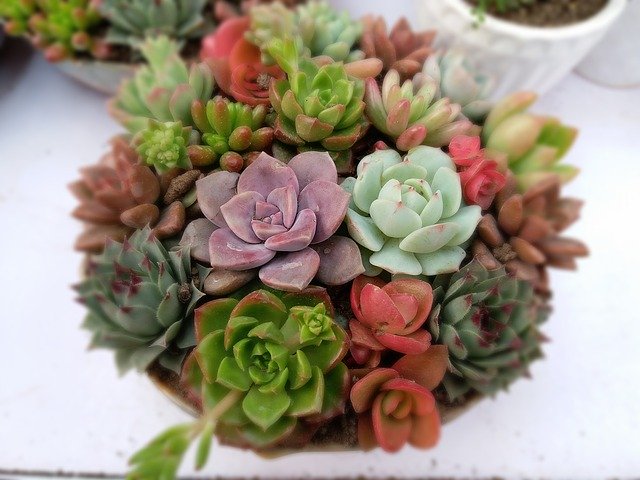No .1 Succulent plants have thick, fleshy and engorged leaves
They have them to retain water in arid climates or soil conditions. The word “succulent” comes from the Latin term sucus, which means juice, or sap. Succulent plants may store water in varied structures, such as leaves and stems. Succulents are usually considered as decorative plants because of their pleasing and strange look, as well as their ability to thrive in relatively less care.
No. 2: High temperature and low rain is their native environemnt
Most plants belonging to families such as Aizoaceae, Cactaceae, and Crassulaceae, are succulents. The habitats of these water preserving plants are in areas with high temperatures and low rain. This is the reason why there are more succulents in semi-desert places in the world than in cold geographical locations. Succulents can thrive in limited water sources, such as mist and dew, that makes them able to survive.
No. 3: Succulent and cacti — The same plant family or not?
The horticultural uses the term succulent regularly that excludes cacti. For example, Jacobsen’s three-volume book of facts about Succulent Plants does not cover cacti. However, in botanical nomenclature, cacti are succulents. Horticulturists may additionally exclude different teams of plants, e.g., bromeliads. In a practical but unscientific horticultural definition “succulent plant is any desert plant that a succulent plant collector desires to grow.”
A further issue is that plants don’t seem to be either succulent or non-succulent. In many genera and families, there is a continual gradation from plants with skinny leaves and traditional stems to those with terribly clearly thickened and fleshy leaves or stems. So deciding what’s a succulent is commonly a subjective arbitrary process. Different sources could classify the same species in different ways.
No .4: Succulents may surprise you in tropical areas
Other than semi-desert areas, succulents also live in tropical locations. Although almost all succulents come from dry areas like steppes, semi-desert, and desert, succulents can thrive virtually anywhere. However, harsh environmental conditions could negatively affect the life of succulents. Extremely low or high temperatures, for instance, could potentially kill succulent plants. Even then, succulents are more resilient than other plants. They can survive in neglect and less care.
No. 5: Succulents are not epiphytes
Succulents are mistakenly considered epiphytes by many people, growing on other plants with restricted or no contact with the ground. People believe that just like other plants in this family, they store water and gain nutrients from other plants they attach to.This is no true however. Succulents are not epiphytes. They need soil to grow, though for a short period of time they can survive without soil.
No . 6: Over-watering is the no. 1 problem succulent growers fact
People favor succulents for their attractiveness and simple care. If properly potted, succulents require very little maintenance to survive indoors. For most plant owners, however, over-watering and infections are the main causes of death in succulents. Terminates, fungi, and other micro intruders can infest your beloved plants. Fortunately you can get rid of infestation quite easily, check my article here for a simple guide.

No .7: Succulents are easy to propagate, in many ways
Succulents can be propagated in different ways. The most common one is vegetative propagation, which means propagating succulents directly from the cuttings of the mother plant. A second method consists in uprooting an overgrown clump and pulling the stems and roots apart.
A third method is a propagation with leaves, letting them callus on the lead stem end. You remove a bottom leaf from the plant, typically by twisting or cutting. The leaf then dries out and a callus forms preventing the leaf from absorbing too much moisture. Just then you place it on the soil and it will grow roots and.
No. 8: Its the sap in leaves that allow succulents to sustain drought and harsh conditions
The sap or juice within the leaves allows the succulents to survive almost total neglect, for some time of course. The plants will use the stored water during the dry season in desert, or when you forget to water them back at home. However, it doesn’t mean that you should experiment with them, wondering how long they will survive with no watering. Care for your plants will love, and they will thank you a thousand times with their timeless beauty.
No. 9: We know about 60 different succulent families
You may consider succulents as one plant family, but the truth is that there are about sixty different families of succulent, each having different colors and textures. Of course, shades of green are the most common. Other colors include pink, blue, purple, yellow, red, and orange in the leaves and also the blooms. These plants are not common, but once you get them, they will attract both your eyes and eyes of your visitors with their unique beauty.
No. 10: Succulents do not have many issues with pests, but some may bother them
Most succulents do not have many issues with pests, such as other plants do. The chalky substance that can be found on the leaves of those plants is meant to safeguard the plant from the extreme sunlight. This same substance also helps shield the plants from pests and diseases that might affect different plants in your garden. To sum it up, if you struggle with pests in your garden, succulents are definitely the plants you should go for!
Final thoughts
Succulents are cute plants full of mysteries. Unlike other plants, succulents can survive a lot of neglect. As long as they get what they need–and that’s not much, they will survive, waiting for better times in their dormant stage.
It is important to remember though that succulents have some needs.If you want to experience their full beauty, see them flowering, etc, you should not neglect them, and care for them with love and protection…. Happy growing!
May also interest you: My complete guide on succulent growing
